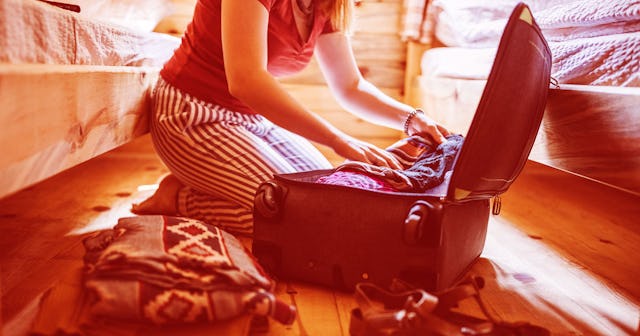Every Family Should Have An Emergency 'Go Bag' — Here's What To Put In It

If packing the essentials in a purse was an Olympic sport, I would win a gold medal. I have so many bags around my house that all have the same items in them. I have a rainbow Kate Spade bag I treated myself to during Pride Month with the same things in it as the black backpack purse that I bought at Target during one of my many impulse buys.
Why do I do this? Because what I need when I am out never changes: hand sanitizer, a face mask or two because someone in my family will forget theirs, lotion, lipgloss, my earbuds, and a quarter (because you never know when you just might need it).
But when there is an emergency, what then? I can’t imagine the fear that would engulf me if I lived through a wildfire this year as thousands did in California, Oregon, and other parts of the West. The Caldor Fires, for example, burned over 200,000 acres of land in California. In an interview with CNN, professor of sociology at Rice University, James Elliott, said, “If you look at disasters across the country over recent decades, there’s almost always stuff going on simultaneously, but what’s changed is the intensity of impact, in part due to climate change but also due to increased development in harm’s way.”
So in the event of such an emergency — if you had to flee your home on a moment’s notice — what would you pack in a bag? Here are a few ideas of things you should load up your “go” bag with which are definitely different than the random things you carry daily. I know I will the next time a hurricane or any other potential disaster comes our way.
If you’re anything like me, the urge to have more in your bag than less will creep in. Push it out. When you pack your “go” bag you want the essentials; the extra lipgloss does not qualify (sorry!)
Daniel Allan/Getty
It’s a good idea to keep documents in a place that is easily accessible should you need them. In a Ziploc bag, keep the following: passports for everyone in your family, an extra debit card, cash, car keys, and house keys, face masks, birth certificates, and phone chargers, and anything else you can think of that 1) needs to stay dry, and 2) you might need to have easy access to.
Once you have your Ziploc bag ready, next it’s time to pick a bag sturdy enough to hold the essentials you’ll need for yourself and your family. The goal in purchasing a bag is that it can survive wind, rain, and heat. Whether or not it looks cute is a bonus, but not necessary, especially when your main goal is to stay alive.
Next up, once you have your bag of choice, you can begin to fill it with the essentials — things like:
- Medications
- Extra pairs of glasses and/or contact lenses and supplies
- Pads and/or tampons
- Tissues
- Flashlights and batteries
- Small, non-perishable or long-lasting food options like (travel-sized) cereal, crackers, nuts
- A few bottles of water
- A travel-sized hygiene kit (or a few) depending on how many people are in your family
- Baby wipes (because duh, they are a godsend)
Remember, you’ll be packing essentials: think underwear, not journals or paper and crayons. It can be tempting to overpack in the name of preparedness, but as Tara Parker-Pope reminds us in The New York Times, “If I need my go bag, it’s because I have a short-term emergency, not because it’s the end of civilization as we know it.”
One more thing to consider when packing is whether this will be a “go” bag for the entire family or if you’ll pack one for each of your kids. If your kids are anything like mine (and they probably are exactly alike on this front), they will forget their “go” bag even if all of ours are together. What will work for my family is one bag that I remember to take in case of a fire or flood.
Your “go” bag should reflect your family’s needs. For my son, who has autism spectrum disorder (ASD), we’d need to pack foods he’d eat. Another thing to consider while we are on the topic, a plan for your pets – do they need a “go” bag too?
No one likes to think about the uncomfortable reality that any one of us could be a victim of a natural disaster, but it’s a fact – and the more prepared we can be, the more peace of mind we’ll have now (and the more easily we can evacuate safely if the need arises). What are you waiting for? Go now and pack your “go” bag while it’s top of mind.
This article was originally published on